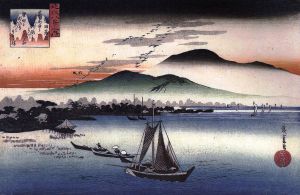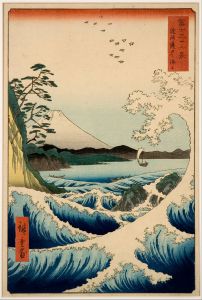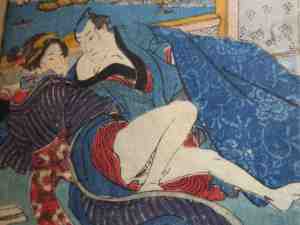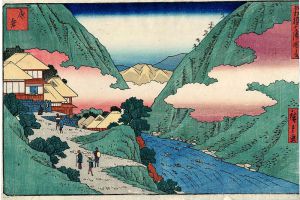Ando Hiroshige: Landscapes, Sexuality, to Buddhist Monk
Lee Jay Walker
Modern Tokyo Times
Japanese art internationally focuses overwhelmingly on rich cultural angles in relation to high culture and adorable landscapes by Edo and early Meiji artists based on different artistic concepts. One of the most famous Japanese artists internationally, without a shadow of a doubt, is Ando Hiroshige (1797-1858). However, the sublime beauty of countless art produced by Hiroshige doesn’t fully portray the real reality of this famous son of Japan.
In other words, the sexual side of Hiroshige is often neglected outside elite international artistic circles. Yet in his native land the erotic reality within ukiyo-e – that focused on such a plethora of different themes – is part and parcel of countless numbers of artists during the Edo period. Equally important, the sexual reality of shunga may not travel internationally in the sense of meaning based on complex cultural traits, different thought patterns, and a more mundane factor being the economic angle.
Collectively, Hiroshige and Katsushika Hokusai helped to generate great interest in Japanese art, albeit if this influence grew after their respective deaths. Of course, many other famous artists have been born in Japan and the rich nature of Japanese art is clear for all to see. Indeed, the many different art forms generated within this country – and the influences of China and Western art after the Meiji Restoration of 1868 – is a wonder to behold. Also, like previously mentioned, Japanese artists influenced many great international artists and this notably applies to the late nineteenth century and early twentieth century.
Time, space, nature, color schemes, and symbolism fuses together just like Buddhism, Confucianism, Taoism, and Shintoism fused aspects of Japanese culture in the past alongside the influences of China. However, while the serenity of Hiroshige is famous you have the backdrop of shunga that is explicitly sexual. This art form also teaches us much about the psyche of aspects of Japanese culture and the sexual reality of Japan. Albeit, the meanings did have different connotations in this period and the natural aspect of explicit art wasn’t based openly on just sexuality.
Within the visions of serenity, sublime nature, and stunning landscapes, you have multi-dimensional realities that may clash in other cultures, irrespective if “Eastern” or “Western” thought patterns. However, open sexuality and conservatism within the same “inner-self” are based on thought patterns that are difficult to grasp from a non-Japanese point of view. This needs to be understood otherwise many confusions will materialize with regards to the duality of such extremes within the art of Hiroshige and many other famous ukiyo-e artists.
Buddhism and Hiroshige
Indeed, this duality can be seen vividly in the last years of Hiroshige’s life because he entered the spiritual realm of Buddhism and became a monk. Therefore, the reality of depicting strong sexual images would not appear to be contradictory nor would it be viewed to be openly sexual within the cultural norms of Japan. In this sense, Hiroshige and other Japanese artists were free from the constraints of the Christian and Islamic dominated world in the same period. Therefore, the next stage leading to Hiroshige becoming a Buddhist monk isn’t so surprising in the context of Japanese culture and values.
This article is not based on giving a deep background of Hiroshige because the images on show express themselves without words. The main theme of the article is based on the duality of Hiroshige and this applies to sublime landscapes and sexual images. Also, the fact that he was born a samurai but died a Buddhist monk is extremely intriguing. After all, individuals from other cultures often miss this contradictory reality. However, it makes perfect sense to Japanese nationals and clearly Buddhism during this period of history was a potent force.
In a sense, the enlightenment learned throughout the life of Hiroshige naturally led to him becoming a Buddhist monk. For the spirituality of passion within his art and passing through many parts of Japan that were equally blessed by Buddhist temples and Shinto shrines, meant that this thinker reached a logical conclusion. Given this reality, the passing of life to the transmigration of the soul within a fusion of art, culture, Buddhism, Shintoism, and within folklore, naturally led to a new path for Hiroshige prior to the next stage.
Therefore, while the Fifty-three Stages of the Tokaido Road, the Eight Views of Lake Biwa, and the Hundred Views of Edo, remain firmly entrenched when thinking about the genius of Hiroshige; it is clear that he had many different angles that ultimately led him to be a Buddhist monk. Of course, the same can be said about many other ukiyo-e artists outside of the Buddhist monk angle. Yet clearly this “hidden world” is fascinating because it tells us much about Japanese culture and different thought patterns. However, individuals need to understand the “real meaning” because the “erotic” angle may be much more mundane outside of the imagination. This applies to the cultural context of Japan in this period of history and the mundane reality of economics.
Some Japanese art and cultural articles by Modern Tokyo Times are republished based on the need to inform our growing international readership about the richness of Japanese culture.
Modern Tokyo News is part of the Modern Tokyo Times group
DONATIONS to SUPPORT MODERN TOKYO TIMES – please pay PayPal and DONATE to sawakoart@gmail.com
http://moderntokyotimes.com Modern Tokyo Times – International News and Japan News
http://sawandjay.com Modern Tokyo Times – Fashion
https://moderntokyonews.com Modern Tokyo News – Tokyo News and International News
http://global-security-news.com Global Security News – Geopolitics and Terrorism
PLEASE JOIN ON TWITTER
https://twitter.com/MTT_News Modern Tokyo Times
PLEASE JOIN ON FACEBOOK
https://www.facebook.com/moderntokyotimes
The photo image is not related to family breakdown and child abuse. On the contrary, it is aimed at the power of the family in caring for children.






